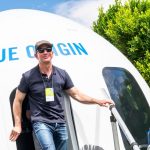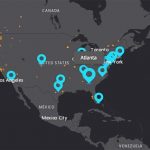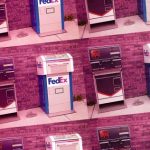How Amazon’s Nonstop Growth Is Creating A Brand-New Seattle
By Glenn Fleishman , August 24, 2017
As I look out the window of my workspace in downtown Seattle, all I see are cranes, construction, and excavations. While this might seem like poetic exaggeration, my perch has put me at the epicenter of Seattle’s transformation from a big little city into something that feels more metropolitan. More accurately, though, it might be called Amazon’s transformation of Seattle.
Amazon’s closest tech peers, old and new, were born in suburbs or decamped there: Microsoft, Apple, Google, Facebook. Jeff Bezos started Amazon in a suburban garage in 1994, but the company has since been housed in a succession of ever-more-expansive digs in Seattle proper: next to a well-regarded barbecue joint south of the now-demolished Kingdome (the “Sodo” neighborhood); in the lovely onetime heroin district downtown, in which office I worked during a six-month stint at the firm in 1996–97; and in a former medical complex that loomed like a supervillain’s gleaming lair high above Seattle as you drove into the city from the south.
John Schoettler, Amazon’s vice president of global real estate and facilities, says that CEO Jeff Bezos told him back in 2005, as the firm considered its plan for when existing leases would expire towards the decade’s end, “I want us to stay in Seattle.” That’s driven the company’s plans since, leading the world’s biggest online retailer to be the city’s biggest—well, almost everything.
Today, Amazon says it has about 8.5 million square feet of space in Seattle (though some real estate sources estimates the figure as closer to 10 million). This gives it roughly 19% of all of the city’s “Class A” (high grade) office space, and about 70% of new downtown office space added in 2016 was exclusively for Amazon. It expects to grow to to 12 million square feet by 2022, but in the past, it’s outstripped its own estimates. Its footprint in Seattle—both economic and physical—will shape the city for decades to come.
Instead of an insular corporate campus with perimeter security, Amazon has checkerboarded the area from the northern edge of downtown, in the Denny Regrade, northward through South Lake Union, a formerly shabby light-industrial area that Microsoft cofounder Paul Allen’s Vulcan Real Estate bought up and transformed, part of Allen’s decades-long influence on the city. Amazon’s flagship towers—Doppler, Day 1, and a third one currently under construction—anchor its campus at the south end. (The building-naming scheme is opaque unless you have an encyclopedic knowledge of the company’s history: “Doppler” was the Echo’s internal codename, and “Day 1” references Bezos’s mantra that at Amazon, it’s “always Day 1.”) The company’s 25,000 downtown employees are also spread less visibly among another 30-odd buildings of all shapes and sizes, most with retail shops and restaurants in the ground floor.
At its towers as well as smaller facilities, Amazon has poked holes, creating breezeways and passages intended as public areas with seating and for eating. It even gives out free bananas—no, this isn’t an Arrested Development joke, but rather a real job for booth workers at two stands. A large area between two city streets abuts its Spheres, geodesic domes filled with plants and trees and intended for employee de-stressing and meetings. Recently, the street in front of the Spheres was blocked for days while contractors dealt with a setback in lifting a 55-foot-tall specimen tree through a space left at the top of one of the domes. They eventually solved the problem, and didn’t use drones.
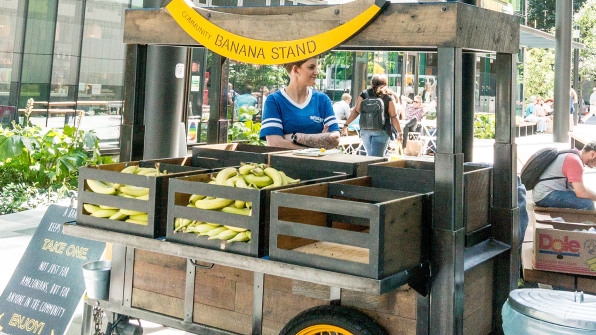
The Spheres space has an oddly large area of artificial turf, possibly awaiting the completion of construction before it’s replaced with real grass, and a tiny dog park, complete with a pooch-washing area. The dog park is open to the public under the watchful eye of what seems to be an omnipresent security guard, but it’s useful for employees, too: The company says Amazonians have registered 4,000 dogs and bring roughly 1,200 into work on an average day. The company’s first dog, Rufus—a dopey and delightful corgi I knew during my time there—gave his moniker to one building (next to another called Wainwright, after Amazon’s first customer) and is celebrated by the construction area’s name: Rufus 2.0.
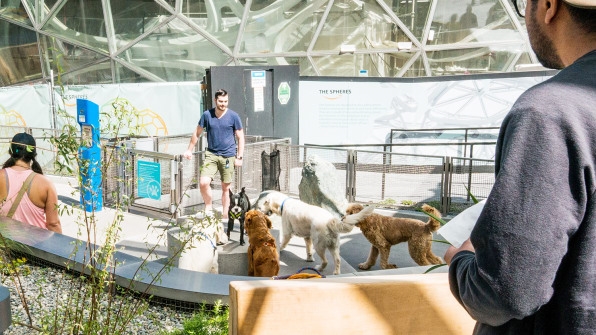
The internal food-service and eating areas at Amazon can only hold about 30% of its employees, the company says, so workers flood the streets at lunchtime. About 35 food trucks pull up around the area daily, and an active restaurant scene ranges from cheap and fast (may I recommend the döner kebab?) to fancy and expensive.
Amazon isn’t shy about its sweeping footprint: It has a nifty printed map that calls out its buildings and started to conduct public tours earlier this year. (Your correspondent received a private equivalent from a company representative.) And its pervasiveness goes far beyond office space, as it uses its hometown’s dense downtown area as a testbed for new ideas. Amazon Fresh. Amazon Locker (first spotted in a local 7-Eleven). Amazon Same-Day—before the official launch, a guy in an unmarked car often pulled up hours after we placed an order to leave a box on our porch. AmazonFresh Pickup, with one location outside Starbucks’s SoDo headquarters. Amazon Go, the bodega with AI eyes to automatically figure out your purchases without a checkout, located in the ground floor of one of the company’s towers. (The store is currently open only to Amazon employees, but I often pass it on my way to Whole Foods Market—soon to be an Amazon outpost itself.)
Cranes Everywhere
In a tight market that it’s made tighter, Amazon isn’t the only company vying for space. Seattle went through a lull in development between the last dotcom boom and the 2007 housing recession, leaving some deep holes in places around the city, including downtown. A map in a meeting room at Amazon’s real estate and facilities offices plots not just its many buildings, but also where competitors have snapped up space and are filling it in with new construction.
Thanks in part to Seattle’s voracious need for new office space, in July, a firm that tracks construction cranes worldwide, Rider Levett Bucknall, said that the city led the U.S. with 58 cranes at work around town. Number two was Los Angeles, which has six times Seattle’s area, with just 36 cranes. Seattle has held its lead—often by far—for some time.
Cranes have a lot of visibility, but the ground-level view is no less profound. Seattle has roughly 35 million square feet of office space downtown—but 5 million of that was added in 2015 and 2016, and 15 million more square feet are in various stages from early-stage permitting through completion by 2020. Sixty-eight buildings were under construction downtown at the end of 2016.
A similar feverish pace has taken over residential buildings: nearly 10,000 apartments are slated to open in 2017 in the downtown area. (Some of them will presumably be snapped up by new Amazon recruits—the company has thousands of open engineering and technical jobs in Seattle.) The 2010s have so far seen more apartments built or under way than the total of the previous 50 years. The U.S. Census Bureau says Seattle grew fastest by far of the 50 biggest metropolitan areas between July 2015 and July 2016, adding almost 21,000 people—over 3% population growth. We grew by 100,000 since April 2010.
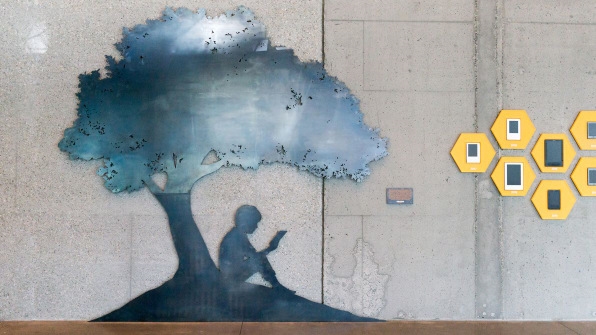
Seattle has gone through this before. For decades, it was a company town, and that company was Boeing, even though its operations were far from the city center and mostly outside its boundaries. My next-door neighbor for many years was a retired Boeing engineer; two of the people who owned my house before I did worked at Boeing. The company employed 100,000 in the region at two peak points.
But a famous billboard posted in 1971 told a story of what happened to the city during the low ebb, following Boeing layoffs of 60,000 workers over four years: “Will the Last Person Leaving Seattle—Turn Out the Lights.” Seattleites with long memories express some concerns about new giants taking Boeing’s place and then decamping. (Boeing still employs 70,000 local workers, but its influence waned after financial mishaps, union-busting efforts, outsourcing jobs to non-union states, and shifting its headquarters—for no solid reason—to Chicago, before quickly burning through two CEOs.)
And while Microsoft has 46,000 local employees, most of them are on an enormous campus (and annex) in Redmond—a suburb a short, congested drive from Seattle across a floating toll bridge—that spreads across 500 acres and 15 million square feet. It’s not on the way to anywhere. Being out of sight has kept it perhaps more out of mind than Boeing or Amazon, despite the perception from non-locals that Microsoft is “in Seattle.”
My neighborhood, close to the Seattle end of the floating bridge, used to be peppered with Microsoft employees; now, I’m just as likely to meet Amazon, Google, and Facebook workers.
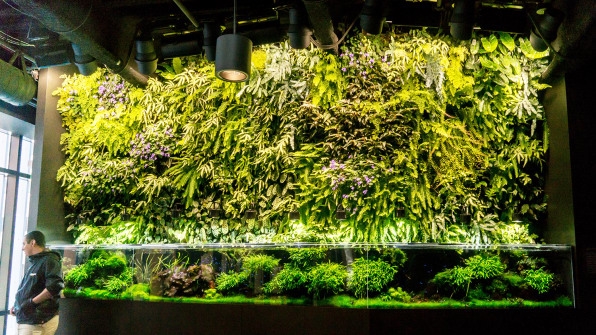
An 800-Pound Corporate Citizen
Even with all the sum of economic activity in the greater Seattle metropolitan area, in which the region also acts as the northern outpost of Silicon Valley firms—many of whom appreciate having another pool of engineering talent they can hire from—Amazon dominates by sheer scale. Its market capitalization and office square footage are one measure. The company recently hit $500 billion in stock value and Jeff Bezos now trades the title of the world’s richest person back and forth with Seattle-area native Bill Gates. (Both live in the formerly rich and now ultra-rich community of Medina, a quick drive from Seattle over a floating bridge on Lake Washington.)
Amazon is also one of the largest employers, with 40,000 people statewide and 25,000 in its HQ area, and Schoettler says it’s the city’s largest taxpayer. (The company benefits from upgrades to Seattle’s public transportation system and has helped to fund them, turning over $5.5 million to the city to pay for a new streetcar and service every 10 minutes during commuting hours.) Its white-collar employees largely earn above the city’s already high median wage, and many staff earn vastly more, given the intense competition for programmers. The region is also flooded with hundreds of millionaires and some billionaires minted across Amazon’s 23-year history here. Because of rises in its stock, a current upper-range employee with several years’ tenure could easily have a net worth above $1 million.
Schoettler says that Amazon is “helping to shape a neighborhood and create a neighborhood,” and he views it as “a lot of responsibility.” That neighborhood shaping by Amazon and others along with the superheated economy has had one big negative: Both real-estate prices and rents have gone through the roof. Seattle has no rent control or stabilization, and landlords can effectively raise prices to any level when leases end. That’s increased what constitutes a livable wage, even as Seattle is a few years into a landmark staggered minimum-wage increase that’s since been taken up by states and municipalities elsewhere, and with unemployment in Seattle close to 3%.
This rising cost of housing is “putting pressure not only on those that are displaced and looking for a place to live, but also for organizations like ourselves,” says Megan Karch, the head of Farestart, a nonprofit that trains people for food-service jobs, runs restaurants to fund its programs, and serves free meals. It’s passed 8,000 people through its program over 25 years. While Karch can’t train people fast enough to meet restaurant needs, she also sees “a greater need and a greater dependence on support systems at our level.”
“We believe that we are in a community crisis of homelessness right now, and it’s our community that will rise up to help us solve this problem,” says Marty Hartman, the executive director of Mary’s Place, an organization that provides temporary housing and a range of social and employment services to women, children, and families in distress. (Seattle and the rest of King County have the third highest number homeless people of any area in the U.S. in absolute numbers, after New York and Los Angeles, and the sixth highest per capita.) Most of what the group calls its guests have jobs, and “97% of homeless families are homeless one time in their whole life,” she says. The group is there to help bridge that gap.
Amazon has partnered with Farestart and Mary’s Place in unique and significant ways that seem to far outweigh any potential public-relations value. Starting in 2015, the company began working with Mary’s Place by offering space for 200 family members in a motel that was slated for later demolition. In July, Amazon moved Mary’s Place to another motel—a slightly nicer one by all reports—a block closer to Amazon’s towers as construction advanced.
Schoettler says employees came to him after the 2015 Mary’s Place announcement and said, “How great this is; this makes me so proud” and then, quickly, “How do I get involved?” Hundreds have volunteered since, and Schoettler says the group’s supply center resembles an Amazon fulfillment warehouse due to donations.
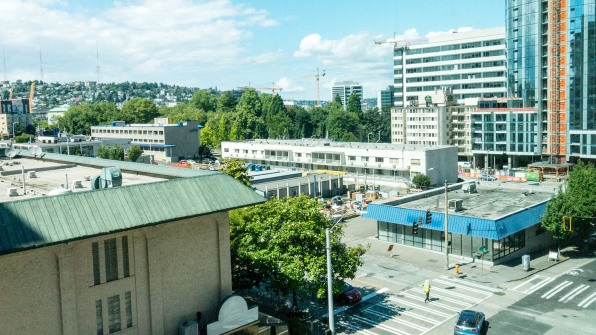
In May, Amazon and Mary’s Place announced the company would build a 65-room, 47,000-square-foot space for the nonprofit within Amazon’s third tower, opening in 2020. Mary’s Place’s executive director Hartman says, “When I got a call from Jeff Bezos and he said, ‘I just want to welcome you to the family’, and I said, ‘How great is that to be wanted?’”
Farestart received similar boosts. In February, Amazon donated 25,000 square feet in Houdini North, a building—named after Prime Now’s codename—at the north end of its loose-knit campus to the group, which opened five distinct casual and quick-serve restaurants there in July. Its executive director, Karch, confirms that the group had trouble hiring enough workers, because it didn’t want to poach graduates from local restaurants. “It’s a good problem to have,” she says.
Finally, in July, Amazon announced a $1 million matching grant for both donations and revenue for Farestart from mid-July to mid-August. “They’re trying to lift all boats,” Karch says.
All this philanthropy may sound a little exhausting, but it comes after nearly 20 years of Amazon and Jeff Bezos donating relatively small amounts. A 2012 Seattle Times article was titled, “Amazon a virtual no-show in hometown philanthropy.” In mid-June of this year, Bezos tweeted the crowdsourced request for ideas on how to engage more in giving, citing Mary’s Place as an example that had moved him.
Without being a bit insincere, Amazon’s location and emerging social conscience and contributions dovetail neatly with its recruiting strategy: To get the workers it wants, it needs to offer not just high salaries, but quality of life. Its newly ambitious local corporate philanthropy effort pairs well with the connection to community that many younger people crave, especially if they’re moving to a new town.
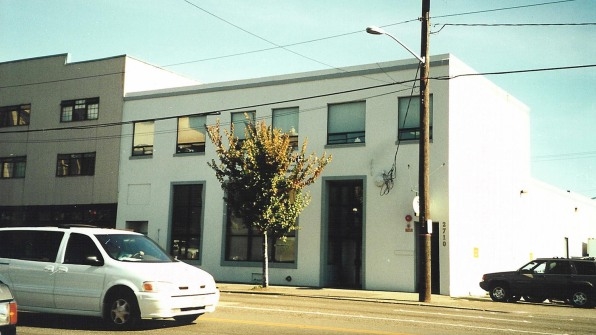
Amazon’s decision to stay downtown, keeping its workers cheek-to-jowl with the reality of a city core, no matter how cleaned up and expensive it becomes, is significant. Karch of Farestart tells a story about the group purchasing its building in 2003. People told her, “You gotta move outside the city.” She persisted, saying, “You’re missing the point. Our point is to be in the city, so those who are homeless can be connected with their community, and those in the community can be connected with the issues of homelessness.”
While Amazon has built its towers of gleaming glass where cheap motels and strip clubs and dive bars once thrived, it doesn’t seem to be looking down on the community around it. As hard as it is to want to credit corporate motivations in an era of cynicism and irony, Amazon has put its buildings where its mouth is.
[Correction, 8/24/17: The original version of this story stated that Microsoft had 30,000 employees in the Seattle area.]
Fast Company , Read Full Story
(69)



